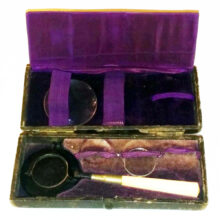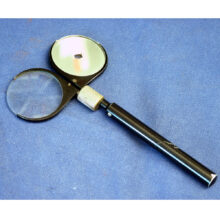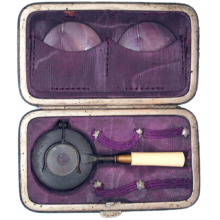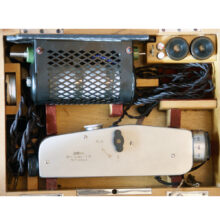Beautiful complete Parent ophthalmoscope and accessories from 1880. It appears to have been used rarely if at all. The only problem is that some of the lenses have come use because of the drying out of the glue that was used at that time.
Here is what The Ophthalmoscope by Hirschberg says about Parent and his ophthalmoscope:
“Parent was born in Neuvireuil, Department Pas-de-Calais in 1849. He entered the Ecole de Médecine Militaire in Strasbourg in 1870. He had to leave there on account of the seige. He continued his studies of military medicine first in Montpellier and then in Paris, where he graduated with a doctorate. After a short stretch as a military physician in Algiers Parent returned to Paris and devoted himself to ophthalmology as a student of Xavier Galezowski. He published all his work for the first twenty years of his scientific activity in Galezowski’s journal, «Recueil d’ophtalmologie. » Later Parent was editor of the «Archives d’ophtalmologie » where he published the most important report of his career. This was a treatise about skiascopy. He was a master of determining the refraction with the upright image. From his teacher Galezowski, Parent developed a special inclination for the examination of the fundus of the eye with the ophthalmoscope. His outstanding atlas of ophthalmoscopy resulted from this. Parent died in 1924.
Parent’s ophthalmoscope was offered for sale in three designs. All three had two discs with spherical lenses as basic parts. The most expensive model cost 60 Francs. The third disc had 10 concave cylinder lenses of 0.5-1-1.5-2-2.5-3-3.5-4-5-6 diopters. The disc can be swiveled around 90° with a lever. The angle of the cylinder axis can be read off.
The model for 50 Francs additionally had a sector with three stenoscopic discs and colored lenses. The simplest type for 40 Francs only had two discs. The white disc was directly behind the mirror. There were 11 concave lenses of 1-2-3-4- 5-6-10-12-15-20 diopters and a convex combination lens of 0.5 diopters. The black disc, facing the observer, had 8 convex lenses of 1-2-3-4-5-6-8-10 diopters and a concave combination lens of 0.5 diopter. For the upright image a small concave mirror is available. It is inclined about 25° and has a short focal distance. For the inverted image there is a concave mirror of the usual focal distance and a magnifying lens.”






















